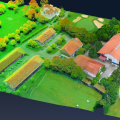
State-of-the-art GIS technology which can create highly detailed 3D maps of entire forests is set to overhaul Australia’s $2.5 billion forestry industry, according to one of the nation’s leading spatial professionals.
The technology, from location intelligence specialists Esri Australia, was on display at SilviLaser 2011, an annual showcase of LiDAR, or light detection and ranging, technology and its applications in forestry.
Esri Australia Senior Consultant Gordon Sumerling, who presented on LiDAR at Ozri 2011 last week, said new advances in GIS technology would ensure Australia’s commercial forests remain sustainable and renewable, and are managed in line with the world's highest environmental standards.
“Forestry is a vital industry in Australia, which has a total forested area of around 150 million hectares – which covers around 21% of our continent,” Mr Sumerling said.
“GIS, when combined with traditional technologies such as LiDAR, can vastly improve critical industry tasks such as assessing forest health, calculating biomass, and identifying drainage patterns and terrain types.
“The 3D maps generated by GIS can enable users to see intricate forest detail such as where and how dense various canopy layers are, and the characteristics of ground level biomass.
“The images also provide a detailed view of topographical changes, which will save an enormous amount of time in terms of hauling loads and positioning machinery.
“This level of insight will be critical in the ongoing sustainable management of our forests.”
LIDAR uses light beams fired from a plane to measure tree and canopy height and terrain.
Mr Sumerling said the Esri Australia’s GIS technology – particularly the soon-to-be-released ArcGIS 10.1 software – transformed raw LiDAR data into 3D maps of the landscape that provided significantly more detail than traditional aerial photographs.
“Aerial photographs only provide views of the actual tree tops, whereas LiDAR can penetrate those and other layers down to the forest floor,” Mr Sumerling said.
“However, in the past LiDAR could only produce simple, 2D images that were mostly useful only to highly trained technicians.
“GIS technology combines multiple 2D LiDAR images and creates highly detailed 3D maps that provide an extremely accurate picture of what forests actually look like – right down to the level of rocks and shrubs on the forest floor.
“This allows non-technical users to get an understanding of the forest floor and tree and canopy heights over vast areas, streamlining decision-making processes while also making them more accurate and informed.”
Mr Sumerling said SilviLaser 2011 was the first time the ArcGIS 10.1 LiDAR applications had been exhibited to Australia’s forestry industry.
“Senior forestry figures have been genuinely amazed by the 3D maps this technology is producing and how it has transformed relatively indecipherable raw data,” Mr Sumerling said.
“They can see the potential this technology has in the industry to revolutionise critical forestry management activities such as biodiversity, fertilisation, harvesting, cultural heritage and development.”
“It’s a very exciting time for Australia’s forestry industry.”







